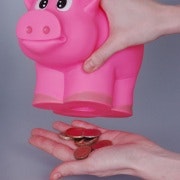Why a forex foray could burn the Reserve
With the Australian dollar trade-weighted index recently around 28-year highs, there have been calls for official intervention to weaken the exchange rate. But suggestions the Reserve Bank might need an injection of capital due to potential losses on its foreign exchange reserves highlights the risk to taxpayers from intervention in foreign exchange markets. The appropriate instrument for addressing concerns about a high Australian dollar is the official cash rate.
Since the Australian dollar was floated in 1983, the Reserve Bank has typically turned a profit on its interventions in foreign exchange markets. The Reserve buys the Australian dollar when the exchange rate is low and sells it when it is high. In its portfolio management operations, the Reserve takes advantage of periods of Australian dollar strength to add to its foreign exchange reserves.
As Milton Friedman argued in his classic defence of speculative activity in foreign exchange markets, such profitability is evidence these market operations have been stabilising on average, although that does not mean they have been particularly influential in determining the value of the exchange rate.
Buying low and selling high has been more challenging in recent years with the Australian dollar seeing strong gains on the back of a rising terms of trade and foreign capital inflows taking advantage of investment opportunities in Australia. Appreciation of the Australian dollar has resulted in unrealised valuation losses on the Reserve Bank's foreign exchange reserves.
According to information released under Freedom of Information legislation, a further 10 per cent appreciation in the Australian dollar could lead to unrealised losses of around $3.4 billion this financial year.
Many consider the Australian dollar overvalued, not least the Reserve Bank itself. The Reserve may be in a position to sell any further additions to its reserves at a profit at a later date if the exchange rate subsequently weakens, but official intervention would implicate Australian taxpayers in a punt on the future direction of the currency.
The Reserve Bank also incurs a cost in selling a relatively high yielding currency like the Australian dollar in order to buy low yielding securities denominated in foreign currencies. The so-called 'carry trade' that makes Australia an attractive destination for foreign investors should also make foreign currency investments unattractive to the Reserve Bank and, by extension, Australian taxpayers.
Indeed, it is questionable whether the Reserve Bank should hold large net long positions in foreign currency assets. It should instead seek to broadly match its foreign currency assets and liabilities.
Foreign exchange reserves give the Reserve Bank the capacity to intervene in foreign exchange markets, but the effectiveness of such intervention is questionable. Currency markets are simply too deep and liquid for official sector purchases to have persistent effects.
Intervention is most effective when seen as signaling the future stance of monetary policy. But a few well-chosen and well-timed words from Governor Stevens can send such a signal far more effectively and at less risk to taxpayers.
It has been argued that Australia is somehow a victim of a 'currency war' being waged between foreign central banks engaged in quantitative easing. Yet there is nothing unusual about the effects of quantitative easing on exchange rates.
Quantitative easing is simply a change in the operating instrument of the central bank, from a price variable (the official interest rate) to a quantity variable (base money).
In itself, quantitative easing tell us nothing about whether central bank policy is easy or tight. Low inflation and low interest rates in countries like Japan and the United States imply policy settings are if anything too tight, not too easy.
The exchange rate is just one of the channels through which a change in monetary policy is transmitted to the rest of the economy and quantitative easing does not fundamentally alter this transmission mechanism.
In previous decades, Australians worried about a low exchange rate and capital flight. In the current international environment, foreign capital inflows are an affirmation of our relatively sound economic fundamentals and not a bad problem to have.
The Reserve Bank already factors the economic implications of the exchange rate into its setting of the official cash rate. Unlike foreign exchange market intervention, further reductions in the official cash rate can ease monetary conditions in Australia without posing unnecessary risks to taxpayers.
Dr Stephen Kirchner is a research fellow at the Centre for Independent Studies.
















